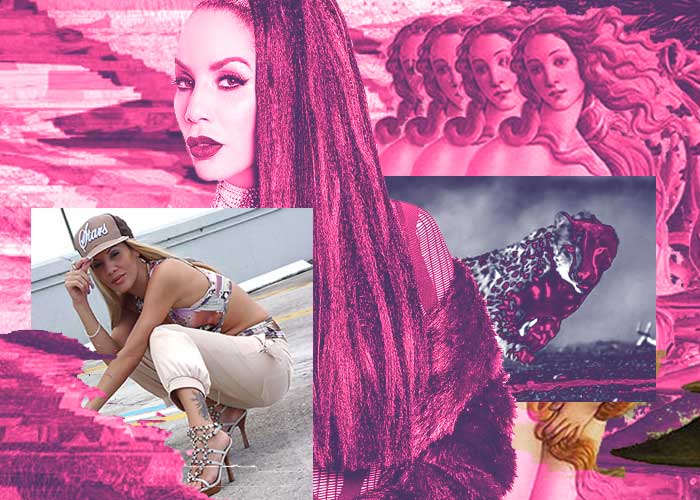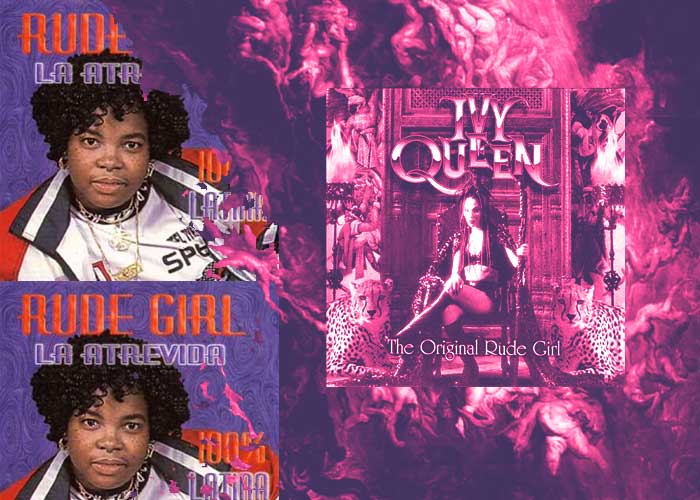Reggaeton began organically as a transformation of dancehall, hip-hop, and reggae en español. As an Afro-diasporic movement, Panama, Puerto Rico, Jamaica, the Dominican Republic, and New York are all pivotal landscapes in the style’s musical evolution. Through Tu Pum Pum: The Story of Reggaeton, a new column by Eddie Cepeda, we’ll explore reggaeton’s history, sociopolitical struggles, and its impact as a global force in music and culture.
Women are the fabric that holds reggaeton together, but they’ve long occupied a tense space between objectification and empowerment in the genre. But without their contributions, reggaeton would be an unlistenable, testosterone-fueled bragging contest, filled with baseless flexing and unsubstantiated claims of sexual conquest. It’s hard to imagine the global domination of a genre that’s partially fueled by uninhibited sexuality without the agency and empowerment that women bring to the table. The bulk of the subject matter in reggaeton, and more often than not, the literal voice that delivers the message, comes from a woman. Some of the most important hooks – those that took regional favorites and transformed them into global smashes, like “Oye Mi Canto” or “Gasolina” – could not work without women.
As a genre that came to light through transculturation and mass migration – sometimes forced, sometimes due to the economics of colonialism – reggaeton always resonated with some facet of the marginalized. But during its first 20-plus years, the male-dominated genre often only invited women into the movement as adornments for the male gaze, all while capitalizing on their efforts, often with little to no recognition. Take Glory and Jenny La Sexy Voz, who committed countless hooks to our collective memory, only to often be left off many of the credits, excluding them from back-end compensation. The anomalous women who managed to break into reggaeton’s mainstream, like Ivy Queen, faced brutal cultural criticism – fraught with the force of respectability politics.

Despite the genre’s early obstacles – record store raids, incessant morality policing, and accusations of inciting violence – reggaeton flourished. As it grew, women constantly carved more space by singing on the hits we all know, dancing in videos, and more recently, curating the future of the genre.
The male-dominated genre often only invited women into the movement as adornments for the male gaze.
Most celebrated reggaeton DJs and producers, like Playero, Nelson, Negro, have traditionally been men. But lately, the task of tastemaking is being led by women in underground spaces. Boiler Room’s first-ever reggaeton showcase served to spotlight three of the selectors making waves in underground reggaeton and urbano music in general: Rosa Pistola, Riobamba, and DJ Bembona. Their curation at underground perreo functions from New York to Mexico City shines a light on emerging talent.
To be clear, women still face the same issues of exploitation and objectification in reggaeton, but now more than ever, women are front and center in taking the movement to new and provocative directions. Though it all began with just a couple of daring reggaetoneras.
Ivy Queen: La Diva, La Caballota, La Potra
Before reggaeton had a name, Panama’s La Atrevida, aka Rude Girl, took a central role in popularizing reggae en español through her participation in the influential 1991 Reggaespanol compilation. She released one album, 1996’s 100% Latina, which included bangers like “Aventura y Romance,” “Gente Vidagena,” and “Día y Noche,” before seemingly disappearing from the music industry. Another early purveyor of the genre was rapper Lisa M, who began her career in underground working with Vico C in the late 80s, and eventually released reggaeton records in addition to rap and merenrap tracks.
But a tipping point for reggaetoneras came when a young rapper named Ivy Queen made her name battling and hyping crowds at San Juan’s iconic The Noise nightclub.
One night in 90s San Juan, the crowd brimmed with anticipation at The Noise, as a young Ivy Queen introduced herself and launched into “Muchos Quieren Tumbarme,” leading the crowd in an enthusiastic call-and-response version of the song. As the track cut off, Queen asked if anyone would like to represent the men in a hype battle. Gran Omar – Ivy’s husband – answered the call, and was quickly ethered by reggaeton’s diva in a battle that included Ivy’s claim that the men in the audience were fed a steady diet of Purina Dog Chow. It was clear that Ivy Queen could battle with the best of them.
Ivy’s first couple of releases failed to fully launch her career, despite high-profile collaborations like “In The Zone” with Wyclef Jean. After a sabbatical, she came back with her breakthrough album Diva, and as we all know, the rest is history. Massive hits like “Quiero Bailar” tackled the issue of consent on the dancefloor, and catapulted her to the top of the reggaeton game.
But unsurprisingly, as one of the first women superstars of the genre, Ivy Queen went through a ringer of abuse. “Honey, I have enough stories to write not one, but several books,” she told Vivala in an interview in 2015. “From the beginning, I had people telling me I needed to be taller, curvier, more tanned, with bigger breasts,” she said.
Ivy Queen was one of the first artists to flip the script on reggaeton’s portrayal of women as submissive objects for male pleasure and desire. Speaking with power and agency, Ivy Queen didn’t let industry criticism get in the way of her success. She eventually became one of the 12 Discipulos, one of the first reggaeton acts to perform at the Latin Grammys.
Ivy Queen has always been an important role model for women in the male-dominated genre. She stood in the face of patronizing politicians and conservative journalists who found new ways to attack reggaeton, including accusing the genre of moral bankruptcy. And as the Mano Dura-era attacks on lyrical obscenity failed miserably, politicians took the next logical step in the battle against the emerging subculture: mass slut-shaming.
“Muchos Quieren Tumbarme”
In 2002, Puerto Rican senator Velda González launched a campaign intended to censure the perceived pornographic and obscene content of reggaeton videos. The campaign alleged that aside from corrupting the youth of the country by leading them to engage in deviant sexual behavior, the women in reggaeton videos were being exploited against their will. Many video stars came out against the censorship, including Yaniv “Tiffany” Burgos Hernandez, who was quoted in Petra R. Rivera-Rideau’s book Remixing Reggaetón: “There is always respect in the videos; none of the artists have gone too far with me, they have given me beautiful friendship.”

As Rivera-Rideau explains in the book, women in reggaeton videos challenged the narrative of respectability the government tried to sell. Women coming out and defending their participation in these videos as an opportunity also sent the message that it was possible to own one’s sexuality.
While the widespread fear of a new genre’s ability to morally corrupt the youth of a country is nothing new, the argument about objectification of women fell flat with fans, and in some instances, the objectified women. Even Senator González conveniently came around to the genre when she saw the potential to reach young voters. The senator’s enthusiasm to embrace the music as it was gaining wider acceptance showed that even the upper echelons of government knew perreo couldn’t be stopped.
Neoperreo and Beyond
These days, reggaeton exists in just about every market across the globe – far outside of the hyperlocal and marginalized spaces that birthed it. Even as the genre enjoys worldwide visibility, it’s proliferating into countless experimental directions in underground scenes across Latin America, in spaces that are distinct from its original poor, black contexts. Notably, some of the most prominent creators in this wave are women.
From La Favi’s emo perreo to Tomasa Del Real’s Internet-born reggaeton, neoperreo is taking the underground to new heights. Rather than sticking to a traditional formula, many of the scene’s rising stars use dembow riddims as a template for experimental sounds.

But it’s not just the sound of reggaeton that’s shifting in the new underground. Women like Ivy Queen broke ground by shattering the tired concept of respectability politics, and cleared the path for women’s increased participation in the genre. And the space widens daily.
Seven months ago, lesbian reggaetonera Chocolate Remix released a video for her song “Como Me Gusta a Mi,” to some shock and even censorship. The video starts with the protagonist exiting a shower and wrapping herself in a towel, before making her way to an overflowing clothing rack, dropping the towel, and dancing topless. As the video continues, the camera pans over multiple women in various states of copulation and undress, in what seems to be a nod to Kanye West’s “Famous.” But unlike “Famous,” and unlike much of the perreo-driven history of reggaeton videos, the women in this video represent all shapes, colors, and sizes. There’s not a single man present. This time it’s by women, for women.
This video, like much of the new generation of women-led reggaeton, shows that it’s increasingly important to create a platform for women to speak from their perspectives. There’s a push to create a bigger space for women to sing about what they want. “Reggaeton songs tell the story of what women want, but it’s a man announcing what it is she wants,” Chocolate Remix told BBC in October. “It seemed like a victory to be able to talk about sex from another space and take advantage of that kind of super obscene language to reflect on other forms of having sex,” she continued.
We’re beginning to see reggaetoneras commanding more space on a larger scale.
Tomasa Del Real, who coined the term neoperreo, told The FADER that she imagines men like having her songs sung to them – a reversal of the classic reggaeton credo. She, like Chocolate Remix, wants women to have a space to sing about their desires within the genre. “Reggaeton lyrics are really strong and they’re usually sung by men. I think people like [my music] because for example, a woman who wants to dance — now she has the opportunity to sing it and dance,” she said in the interview.
While the mainstream charts have yet to fully reflect this gradual shift, we’re beginning to see reggaetoneras commanding more space on a larger scale; artists like Karol G and Natti Natasha are steadily releasing new material. Though the mainstream is still run by men, the work put forth by La Favi, Ms. Nina, Tomasa Del Real, and others could eventually translate to increased mass-market visibility for women. Of course, questions of colorism remain – it’s worth thinking about how some new reggaetoneras benefit from a system that deters darker-skinned artists from the visibility and success some of their lighter-skinned peers have achieved. But as musical history has always shown us, the underground always informs the mainstream. In fact, as we all know, that’s how this whole genre came to exist in the first place.
Stream a playlist curated by Remezcla Music Editor Isabelia Herrera featuring these artists and more:







